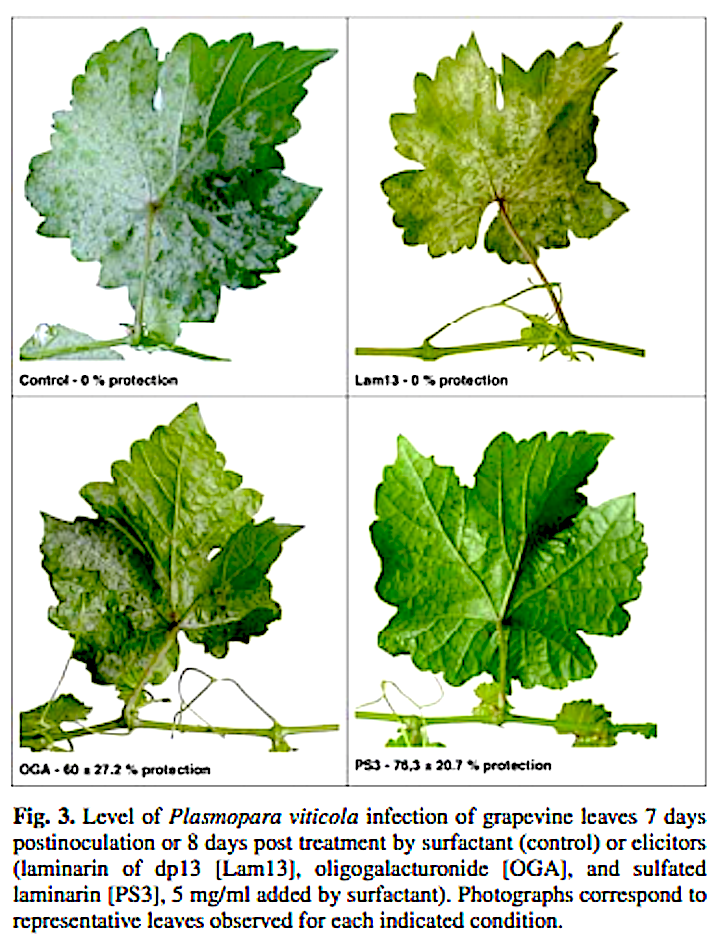====================
在葡萄藤中,硫酸化的拉曼纤维素(PS3)在叶片的气孔背面表面上的渗透率远高于叶片的上表面,在与Dehscofix CO125(DE)配制时才能穿透叶子的角质层。
Na videira, a taxa de penetração da laminarina sulfatada (PS3) foi muito maior na superfície abaxial estomática da folha do que na superfície adaxial, sendo capaz de penetrar na cutícula da folha apenas quando formulada com Dehscofix CO125 (DE).
En la vid, la tasa de penetración de la laminarina sulfatada (PS3) fue mucho más alta en la superficie abaxial estomática de la hoja que en la superficie adaxial, siendo capaz de penetrar la cutícula de la hoja solo cuando se formula con Dehscofix CO125 (DE).
==============
An ethoxylated surfactant enhances the penetration of the sulfated laminarin through leaf cuticle and stomata, leading to increased induced resistance against grapevine downy mildew
Paris F., Krzyżaniak Y., Gauvrit C., Jamois F., Domergue F., Joubès J., Ferrières V., Adrian M., Legentil L., Daire X., Trouvelot S. (2015)
Franck Paris, Yuko Krzyżaniak, Christian Gauvrit, Frank Jamois, Frédéric Domergue, Jérôme Joubès, Vincent Ferrières, Marielle Adrian, Laurent Legentil, Xavier Daire, Sophie Trouvelot,
Université de Bourgogne, UMR 1347 Agroécologie, ERL CNRS 6300, Dijon, France
===
Physiologia Plantarum 156(3): 338-350 – https://doi.org/10.1111/ppl.12394 –
https://onlinelibrary.wiley.com/doi/10.1111/ppl.12394
Abstract
Some β-1,3-glucans and particularly sulfated laminarin (PS3) are known as resistance inducers (RIs) in grapevine against the downy mildew. However, their efficacy in vineyard is still often too low, which might be caused by a limited penetration through the leaf cuticle following spray application. We used 14C-sucrose uptake experiments with grapevine leaves in order to select a surfactant as saccharide penetration enhancer. Our results showed that although sucrose foliar uptake was low, it was strongly enhanced by Dehscofix CO125 (DE), a highly ethoxylated surfactant. Fluorescent saccharides were then produced and laser scanning microscopy was used to analyze their foliar diffusion pattern in Arabidopsis thaliana and grapevine. Interestingly, sucrose and PS3 were seemingly able to penetrate the leaf cuticle only when formulated with DE. Diffusion could preferentially occur via stomata, anticlinal cell walls and trichomes. In grapevine, PS3 penetration rate was much higher on the stomateous abaxial surface of the leaf than on the adaxial surface. Finally, using DE allowed a higher level of downy mildew control by PS3, which corroborated diffusion observations. Our results have practical consequences for the improvement of treatments with saccharidic inducers on grape. That is, formulation of such RIs plays a critical role for their cuticular diffusion and consequently their efficacy. Also, spray application should preferentially target the abaxial surface of the leaves in order to maximize their penetration.


You must be logged in to post a comment.